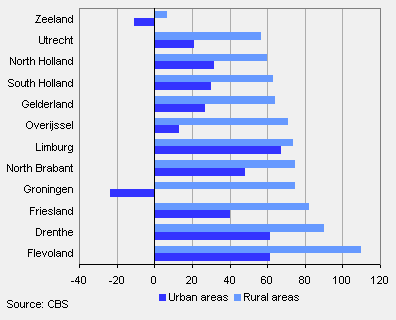Narrowing gap between number of facilities available in urban and rural areas

In 2009, the number of facilities per 100 thousand residents in the Netherlands had increased by 4 percent relative to 2005. In urban areas, the increase was more than 6 percent. The facility rate per 100 thousand residents living in rural areas was 1,159, i.e. 29 fewer than for residents living in urban areas. In 2005 and 2001, the differences were 65 and 115 respectively.
Difference in number of facilities per 100 thousand residents, 2005-2009

Sharpest growth in Flevoland
The facility level improved most in the province of Flevoland. The increase occurred in urban as well as rural polder communities, but the facility rate per 100 thousand residents in Flevoland is still far below the nationwide average. In urban municipalities in Flevoland (Almere and Lelystad), the level of services available is still considerably lower than in urban municipalities elsewhere in the Netherlands.
The facility rate per 100 thousand residents dropped only in urban areas in the provinces of Zeeland and Groningen. The facility level improved in the rural areas in all other Dutch provinces.
Difference in the number of food shops per 100 thousand residents, 2005-2009

Sustained decline in number of food shops
Over the period 2005-2009, the number of food shops per 100 thousand residents was reduced further from 110 in 2005 to 99 in 2009. With 131 per 100 thousand residents, the rate was even higher in 2001. The number of butcher shops, bakeries and greengroceries is declining remarkably.
More services, fewer catering facilities
The number of hairdressers, fitness centres and photography shops increased most substantially between 2005 and 2009. In rural as well as urban regions, the number of places to go out declined. There is also a shift from urban to rural areas with respect to retail trade in transport, leisure and other shops. Cultural activities are increasingly found in urban areas.
Hub Beunen